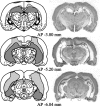Essential role of the hippocampal formation in rapid learning of higher-order sequential associations
- PMID: 16611828
- PMCID: PMC6673879
- DOI: 10.1523/JNEUROSCI.0441-06.2006
Essential role of the hippocampal formation in rapid learning of higher-order sequential associations
Abstract
Evidence from studies of amnesia and functional imaging in humans suggest that the medial temporal lobe is involved in the learning of higher-order sequences during acquisition of serial reaction time (SRT) tasks. However, these studies have not clarified whether the hippocampal formation specifically is essential to this type of learning. Here, we developed a rodent model of the SRT task to examine the specific roles of the hippocampal formation in learning first- and second-order conditional sequences. Selective hippocampal formation lesions speeded performance and impaired accuracy on both first- and second-order sequences. Additionally, whereas controls distinguished the sequences based on their complexity alone, animals with hippocampal lesions initially differentiated sequences only by their length. Over multiple sessions, hippocampal rats gradually differentiated sequences by their complexity and not length, similar to control subjects. These findings indicate that the hippocampal formation itself plays an essential role in rapid acquisition of higher-order sequence representations. Extrahippocampal systems can also acquire complex sequential representations, albeit via a gradual learning mechanism.
Figures



References
-
- Burgess N, Maguire EA, O’Keefe J (2002). The human hippocampus and spatial and episodic memory. Neuron 35:625–641. - PubMed
-
- Curran T (1997). Higher-order associative learning in amnesia: evidence from the serial reaction time task. J Cogn Neurosci 9:522–533. - PubMed
-
- DeCoteau WE, Kesner RP (2000). A double dissociation between the rat hippocampus and medial caudoputamen in processing two forms of knowledge. Behav Neurosci 114:1096–1108. - PubMed
-
- Eichenbaum H (2004). Hippocampus: cognitive processes and neural representations that underlie declarative memory. Neuron 44:109–120. - PubMed
Publication types
MeSH terms
Grants and funding
LinkOut - more resources
Full Text Sources
